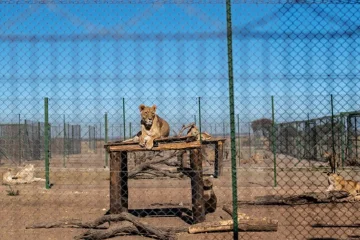VITALIO ANGULA, BIRD STORY AGENCY
DR Audrey Delsink has always been saddened by the plight of animals at the hands of humans. However, her interest in elephants started later on in her career.
Upon completion of her graduate studies, she worked as a field guide and game ranger at Manyeleti Game Reserve, south of the Kruger National Park in South Africa where she crossed paths with elephants who were not used to vehicles and people.
“I was actually very scared of elephants but when I moved to another private game reserve, much smaller than Manyeleti, I encountered a completely different side to them,” said Delsink.
Here, she started a journey that has earned her the nickname; ‘Africa’s Elephant Doctor’.

“It was through my initial fear and later spending time with elephants that I realised that their societies are very much like ours.
According to Delsink, during this time, it became more apparent to her that many of today’s animal issues were more as a result of habitat loss.
“it absolutely shocked me that the quickest solution by humans was to resort to lethal control,” Delsink explains.
This realisation started her on a path of alternatives. A graduate of the University of KwaZulu-Natal, Delsink completed her Doctoral Thesis titled: African Elephants Spatial Ecology, Population Control and Human Interactions: Implications for Management through the School of Life Sciences under Professor Robert Slotow.
“It looked at how we as humans affect elephant movement through our management and interventions, and developed novel, risk-based, practical solutions for pre-emptive conflict mitigation,” Delsink explains.
The question of human-elephant conflict remains a major conservation concern that Delsink is working to answer.
In her role as Wildlife Director of Humane Society International-Africa an affiliate of Humane Society International, one of the largest animal protection organizations in the world, she is working on key campaigns, as interventions, one of which is immunocontraception.
Her work brings the science of immunocontraception and animal biology together to bridge the gap between stakeholders and managers. This was specifically geared towards managing the elephant conflict in a way that is biologically relevant to the animal.
This alternative features an elephant vaccine for the humane, non-lethal, and reversible population control of elephants in differing protected areas and landscapes.
Immunocontraception is a non-hormonal form of contraception that uses the animal’s own immune system to produce antibodies against the proteins in the vaccine, which specifically attaches to the sperm receptor site in the female’s egg thereby blocking fertilization by the sperm.
Delsink explains that depending on the number of animals in a designated area, the vaccine is administered using a two-compartment dropout dart via helicopter. One compartment expels a marking substance on the animal while the second compartment is the vaccine itself.
The vaccine was originally produced by Doctor Irwin Liu of the University of California Davis School of Veterinary Medicine followed by Doctor Jay Kirkpatrick in the early nineties for the Animal Welfare Institute in the United States of America and was first used for the population control of wild horses and whitetail deer, Delsink explained to Bird.
According to Delsink, immunocontraception maintains elephants in their existing habitat and reduces growth rates, “reducing local densities, thereby reducing opportunities for conflict with humans,” she says “People rely on lethal mitigation as the quickest solution but there are alternatives and my team and I are prepared and willing to work with authorities on the continent to design programs to mitigate these challenges,” Delsink reiterated.
The growing human population is significant in reducing wildlife habitat, especially the elephants. According to Delsink, as of 2016, elephants had lost about sixty percent of their historic range in the savannah habitat.

As their domain shrinks, elephants are progressively forced into closer contact with humans, sparking frequent and severe conflict over space and resources.
As part of an international team of pioneers in alternative methods for elephant population control on the African continent, Delsink is adamant that co-existence between humans and elephants is possible if only key stakeholders were not reluctant to take up alternative methods of population control such as immunocontraception.
“Human-animal conflict remains a challenge in African range states, awareness of some of the methods available to protect elephants and ultimately people are available but there is not a quick uptake,” Delsink says.
Despite this friction, elephants and humans share a number of characteristics and their movements are inextricably linked.
“They are extremely close-knit, matriarchal by family structure, are profoundly cognitive beings and it is through the process of making these observations that my passion and life’s work with elephants began,” she narrated as she gave us a glimpse of her personal interaction with these majestic mammals.
Furthermore, elephants have been called one of the ‘Big Five’. Delsink explains that they are ecosystem engineers because of their role in producing a change in the ecosystem.
“Elephants are capable of ecosystem change both positive and negative and are critical for positive interactions with a whole range of other species,” she says.
Supporting Delsink’s claims, the Secret Work of Elephants written by Ralph Chami et al posits that “as African elephants make their way through the rain forests and forage for food, they thin out young trees that are competing for space, water, and light-by stepping on some and consuming others”.
The existence of the African Elephant is further threatened by the significant increase in poaching. Approximately 97 elephants are gunned down daily by poachers who voraciously kill them for their prized ivory.
Commercial trade in endangered species has dominated global headlines with the Convention on International trade in Endangered Species of Wild Fauna and flora, (CITES), scheduled to host a standing committee meeting in France this month to discuss the annotation regarding elephant translocation to countries outside of African rangelands as a method of population control, a practice that Delsink is vehemently against.
In 2016, experts estimated that Africa’s elephant population had dropped by 111,000 elephants in the span of a decade. Today, there are just 415,000 elephants across the continent.

Scientists predict that if this trend continues, there could be no elephants left in the wild by 2030.
“A new census is currently being undertaken and the best predictor of the future is the past,” Delsink explains.
“African Savannah Elephants have declined by fifty percent in the last three generations, their population trend is declining and likely irreversible and they have been recently classified as endangered, at this current trajectory and given myriad threats that face elephants the anticipated future extinction of elephants within the next hundred years is likely to be inevitable,” she continues.
Apart from her Doctor of Philosophy degree in biology, she is also a registered ecologist with the South African National Council for Scientific Professionals. An ardent supporter and advocate for the safeguarding of the planet, Delsink continues to change the narrative of human-wildlife conflict between communities in Africa demonstrating that elephant populations can be reduced and mitigated in non-lethal ways.














